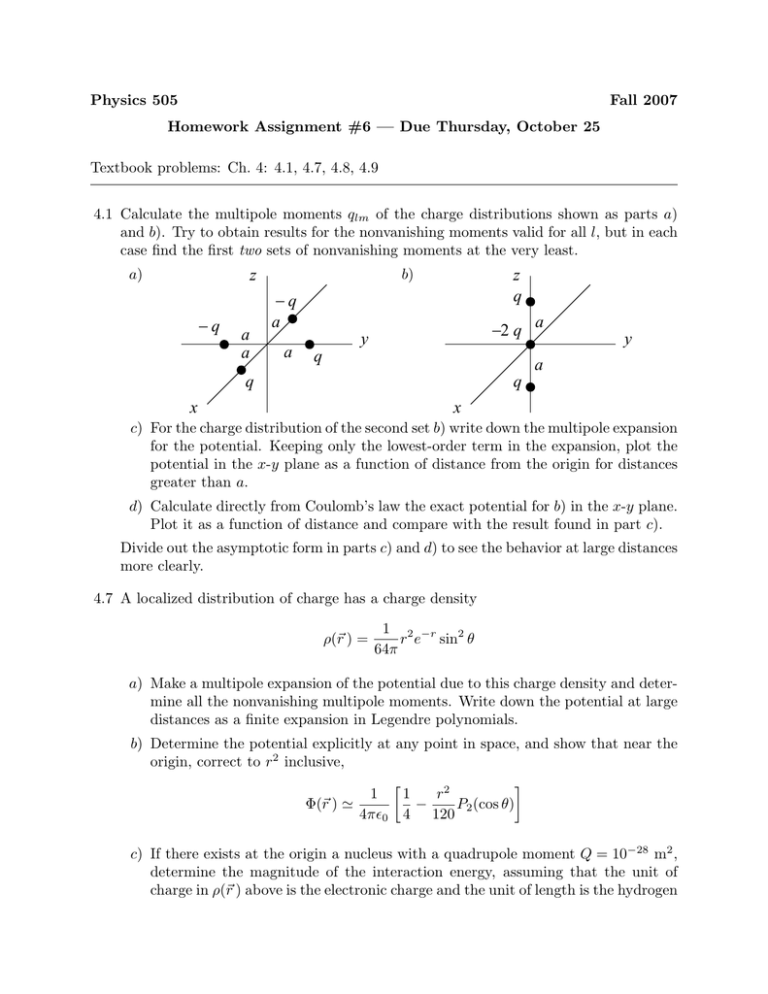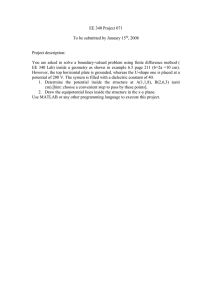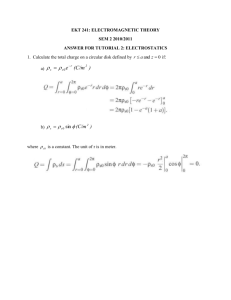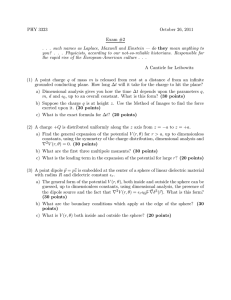z a aq q q q − − a a x y − a x y z q q a q 2
advertisement

Physics 505 Fall 2007 Homework Assignment #6 — Due Thursday, October 25 Textbook problems: Ch. 4: 4.1, 4.7, 4.8, 4.9 4.1 Calculate the multipole moments qlm of the charge distributions shown as parts a) and b). Try to obtain results for the nonvanishing moments valid for all l, but in each case find the first two sets of nonvanishing moments at the very least. z a) −q a a z q b) −q a a a −2 q y q y a q q x x c) For the charge distribution of the second set b) write down the multipole expansion for the potential. Keeping only the lowest-order term in the expansion, plot the potential in the x-y plane as a function of distance from the origin for distances greater than a. d) Calculate directly from Coulomb’s law the exact potential for b) in the x-y plane. Plot it as a function of distance and compare with the result found in part c). Divide out the asymptotic form in parts c) and d) to see the behavior at large distances more clearly. 4.7 A localized distribution of charge has a charge density ρ(~r ) = 1 2 −r 2 r e sin θ 64π a) Make a multipole expansion of the potential due to this charge density and determine all the nonvanishing multipole moments. Write down the potential at large distances as a finite expansion in Legendre polynomials. b) Determine the potential explicitly at any point in space, and show that near the origin, correct to r2 inclusive, 1 1 r2 − P2 (cos θ) Φ(~r ) ' 4π0 4 120 c) If there exists at the origin a nucleus with a quadrupole moment Q = 10−28 m2 , determine the magnitude of the interaction energy, assuming that the unit of charge in ρ(~r ) above is the electronic charge and the unit of length is the hydrogen Bohr radius a0 = 4π0 h̄2 /me2 = 0.529 × 10−10 m. Express your answer as a frequency by dividing by Planck’s constant h. The charged density in this problem is that for the m = ±1 states of the 2p level in hydrogen, while the quadrupole interaction is of the same order as found in molecules. 4.8 A very long, right circular, cylindrical shell of dielectric constant /0 and inner and outer radii a and b, respectively, is placed in a previously uniform electric field E0 with its axis perpendicular to the field. The medium inside and outside the cylinder has a dielectric constant of unity. a) Determine the potential and electric field in the three regions, neglecting end effects. b) Sketch the lines of force for a typical case of b ' 2a. c) Discuss the limiting forms of your solution appropriate for a solid dielectric cylinder in a uniform field, and a cylindrical cavity in a uniform dielectric. 4.9 A point charge q is located in free space a distance d from the center of a dielectric sphere of radius a (a < d) and dielectric constant /0 . a) FInd the potential at all points in space as an expansion in spherical harmonics. b) Calculate the rectangular components of the electric field near the center of the sphere. c) Verify that, in the limit /0 → ∞, your result is the same as that for the conducting sphere.




